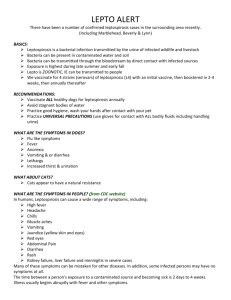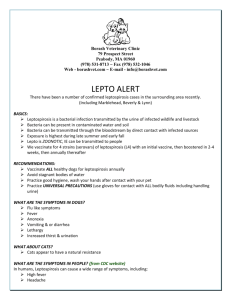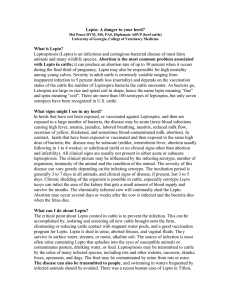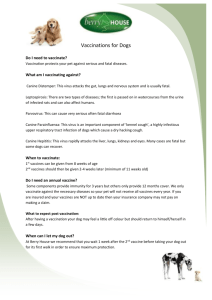Pet Page
advertisement
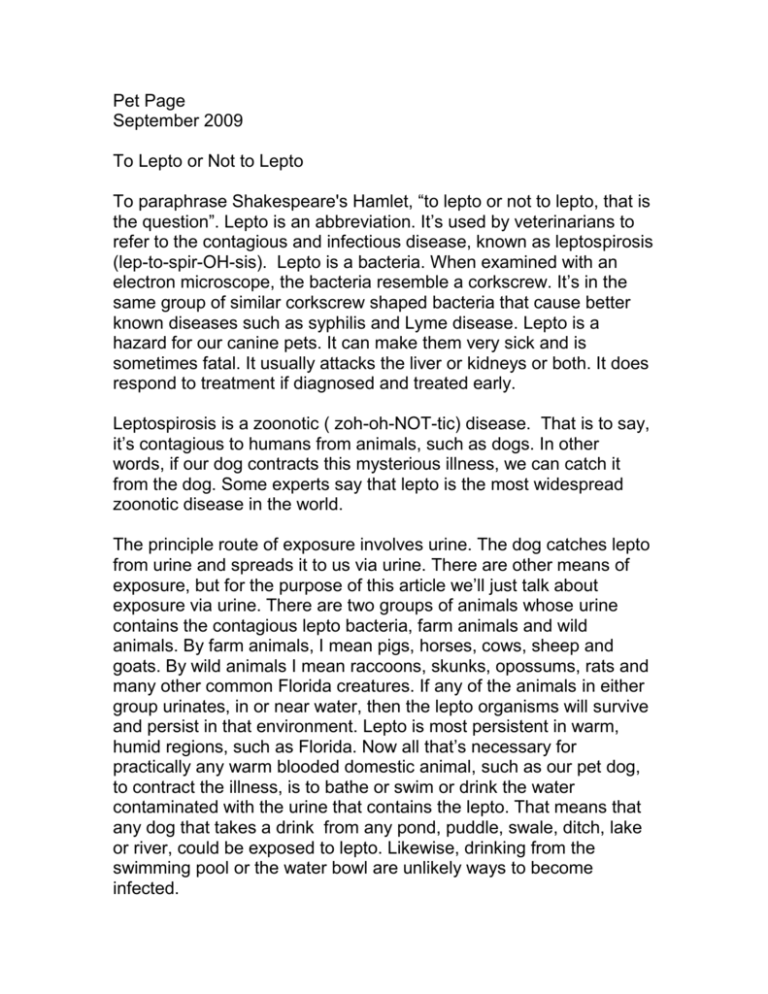
Pet Page September 2009 To Lepto or Not to Lepto To paraphrase Shakespeare's Hamlet, “to lepto or not to lepto, that is the question”. Lepto is an abbreviation. It’s used by veterinarians to refer to the contagious and infectious disease, known as leptospirosis (lep-to-spir-OH-sis). Lepto is a bacteria. When examined with an electron microscope, the bacteria resemble a corkscrew. It’s in the same group of similar corkscrew shaped bacteria that cause better known diseases such as syphilis and Lyme disease. Lepto is a hazard for our canine pets. It can make them very sick and is sometimes fatal. It usually attacks the liver or kidneys or both. It does respond to treatment if diagnosed and treated early. Leptospirosis is a zoonotic ( zoh-oh-NOT-tic) disease. That is to say, it’s contagious to humans from animals, such as dogs. In other words, if our dog contracts this mysterious illness, we can catch it from the dog. Some experts say that lepto is the most widespread zoonotic disease in the world. The principle route of exposure involves urine. The dog catches lepto from urine and spreads it to us via urine. There are other means of exposure, but for the purpose of this article we’ll just talk about exposure via urine. There are two groups of animals whose urine contains the contagious lepto bacteria, farm animals and wild animals. By farm animals, I mean pigs, horses, cows, sheep and goats. By wild animals I mean raccoons, skunks, opossums, rats and many other common Florida creatures. If any of the animals in either group urinates, in or near water, then the lepto organisms will survive and persist in that environment. Lepto is most persistent in warm, humid regions, such as Florida. Now all that’s necessary for practically any warm blooded domestic animal, such as our pet dog, to contract the illness, is to bathe or swim or drink the water contaminated with the urine that contains the lepto. That means that any dog that takes a drink from any pond, puddle, swale, ditch, lake or river, could be exposed to lepto. Likewise, drinking from the swimming pool or the water bowl are unlikely ways to become infected. The principle signs of leptospirosis infection in dogs are vague. The signs usually involve lethargy and anorexia. In other words, the affected pet just lies around and won’t eat. Often there is vomiting. The illness may not manifest itself for days or weeks after ingesting the contaminated water. There are good tests to diagnose the disease if the doctor keeps it in mind as a possible cause of the dog’s illness and if the client’s budget allows the extra tests to be performed. Almost every vet has diagnosed a dog with lepto. Most vets have seen more than one case. If you multiply that by the number of vets it’s easy to appreciate there are hundreds of cases of lepto reported in dogs in Florida. There are good vaccines available to protect dogs. There are, however, some drawbacks to vaccinating. The least effective vaccines are the ones that combine the lepto with other vaccines such as distemper and parvo. These vaccines usually appear on the receipt or record as a group of initials, such as DHLP-P or DALPP. The most effective lepto protection comes from vaccines that contain four serovars, or four different types of lepto protection. Currently these vaccines are only available from Pfizer or Ft. Dodge. Why not vaccinate every dog for lepto? Well, some vets do, but there are some drawbacks. The vaccine is an additional expense. The vaccine doesn’t cause many reactions, but in my experience it causes more reactions than any of the other vaccines, especially in small dogs. This is unfortunate as nearly forty percent of the allcanine lepto cases occur in dogs less than 25 pounds. It may not protect for a full year, so excellent protection may take twice a year shots. And like any other vaccine, just because you vaccinate, it’s not a guarantee you pet won’t get the illness. So, the appropriate thing to do is ask your veterinarian whether to vaccinate your dog for leptospirosis or not.
